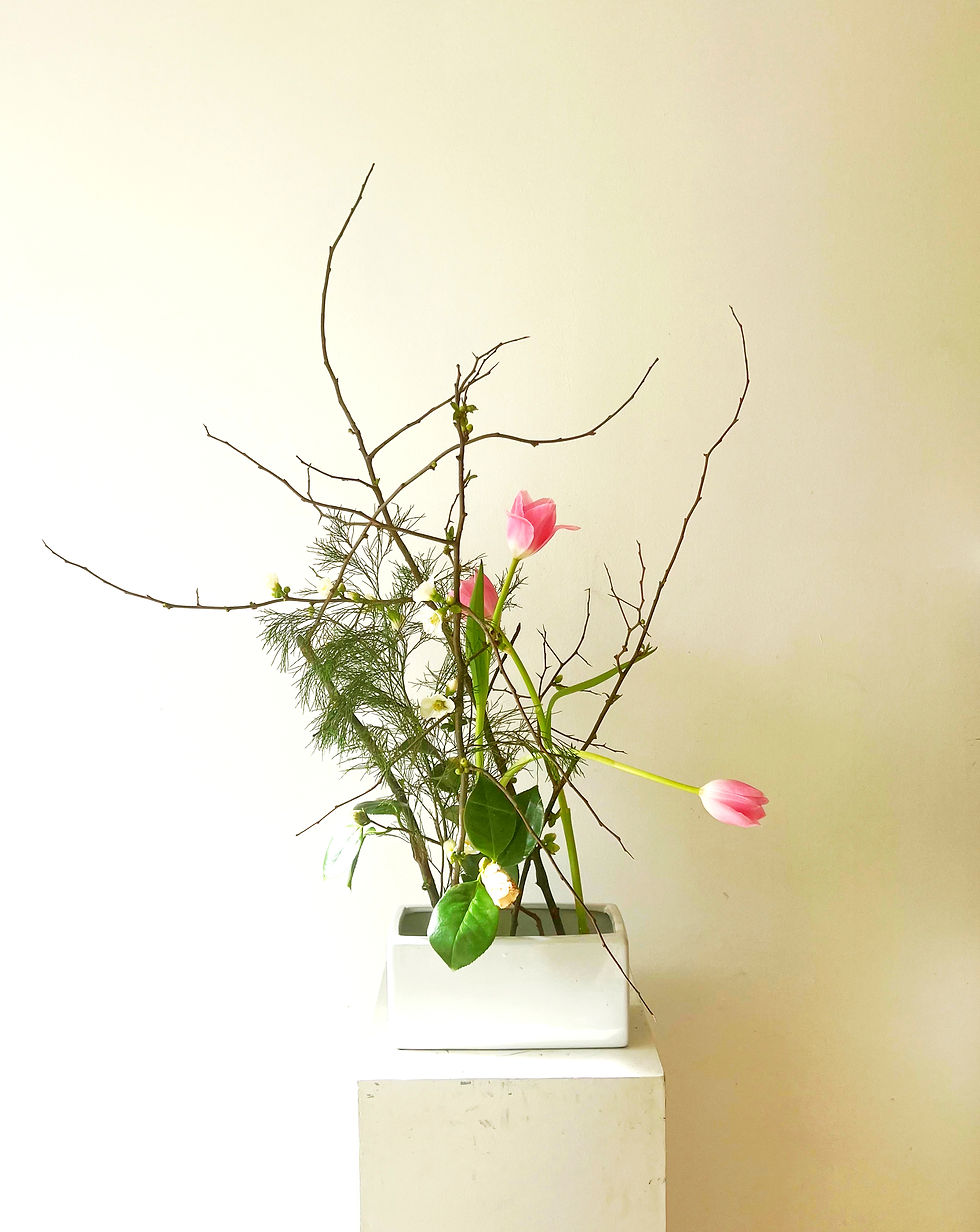Natural Crossings in Ikebana
- Azumi
- Jul 27
- 3 min read
Embracing Intentional Chaos
Flowering quince, commonly known as Japonica, is a unique branch with a strong personality. Its lines may start out straight but quickly twist, bend, or split in unexpected ways, each forming its own expressive path.So, how do we work with such a strong and unpredictable branch in ikebana?
Traditionally, ikebana highlights a single, strong line, with crossing branches often removed to maintain clarity and focus. But with Japonica, those intersections are part of its nature. Its random, overlapping growth can be embraced as a unique design feature.Rather than trimming away its complexity, we can choose to highlight it. By allowing the branches to cross like a lattice, we create structure and order within the design. When paired with tulips, gently curving into the structure, Japonica reveals both a framework of crossing lines and a harmony of wildness and grace.

Crossing Style
The crossing style may look complex—even chaotic at first. But when guided by a thoughtful sense of order, the intersecting lines come together to form a design that feels both intricate and natural.
Compared to parallel or radiating forms, the crossing style requires more technical skill. It’s not just about making lines cross—each flower’s natural form must be respected. The key is to observe carefully, find each element’s natural angle, and place it in a way that maintains harmony and rhythm.
Flowers used : Flowerin quince ( Japonica, Tulip, Bribie Pine, Camellia )
Design Approach and Considerations
Quince grows in a natural, irregular way, with many small branches that often cross the main one. If the main branch is placed at the right angle, those side branches may cross naturally.
In this style, those natural crossings are embraced as part of the design. When using more than one branch, there’s no need to force them to cross just follow their natural shape and let them move freely.
In crossing-style ikebana, the intersection of branches becomes a key feature. It’s most effective when placed higher in the design, where it catches the eye and creates a soft, tangled impression. If all the crossings happen near the base, the design may feel accidental or crowded. Choose open spaces for the crossings so each branch can move freely and express its natural character within the whole.
When choosing crossing points, view your design from different directions—not just side to side. Try front-to-back crossings for depth or diagonal lines to add dimension. This expands the visual outline of the work. The key is to make the crossings feel natural, as if the branches met on their own.
If the design feels too tight, try gently rotating or shifting the kenzan rather than repositioning the branches. A small shift at the base can help open up space and give the overall design a more natural and relaxed flow.
Tulips have a soft, flowing energy that contrasts beautifully with the strong lines of quince.
Try placing tulips so their stems cross each other, creating a gentle rhythm that blends with the structure.
Bribie pine has a misty texture, like light fog. Place it in a way that feels airy and floating. If overused, it can fill the space between branches and distract from the crossing lines. It’s best used in just one or two areas as a soft accent.
A few camellia leaves can add stability and a sense of visual rest. They help maintain quiet balance within the tangled branches, keeping the structure clear and composed.
How to Find the Right Angle of Quince
Flowering quince has a strong and sometimes unpredictable nature, making it tricky to identify the correct angle and face of each branch.
One helpful tip is to observe the color of the bark or darker areas often face the sun. Also, look at the direction of the leaves rather than the flowers. Leaves naturally grow toward the sunlight and can give you a better clue about the branch’s true face. Flowers may point in different directions, but the leaf side usually shows the natural front.
Quiet Reflection
By working with the natural flow of flowering quince and embracing the complexity of its crossing lines, the artist creates more than just a compositionthey reveal the rhythm and detail of the flower’s most captivating features. Each branch is allowed to speak, transforming the design into a quiet yet powerful reflection of nature’s spontaneous rhythm and grace.
Author : Azumi Ishikawa / Ikebana Master and Artist
Ask your question
0%Write an answer













Comments